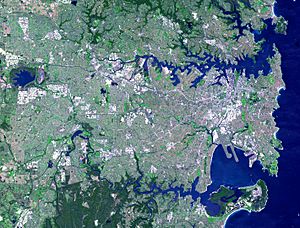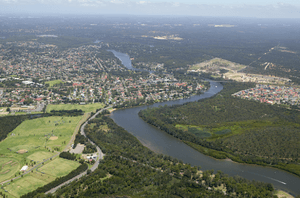Georges River facts for kids
Quick facts for kids Georges River |
|
|---|---|
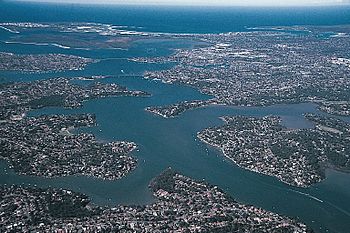
|
|
|
NASA satellite view of Greater Metropolitan Sydney, with the location of the mouth of the Georges River, as marked
|
|
| Other name(s) | Tucoerah River |
| Country | Australia |
| State | New South Wales |
| Region | Greater Metropolitan Sydney |
| LGAs | Wollondilly, Campbelltown, Liverpool, Fairfield, Canterbury-Bankstown, Sutherland, Georges River |
| Physical characteristics | |
| Main source | Upland swamps, O'Hares Creek east of Appin, Macarthur region 350 m (1,150 ft) 34°15′00″S 150°49′48″E / 34.25000°S 150.83000°E |
| River mouth | Botany Bay Taren Point 34°0′35.994″S 151°7′47.6394″E / 34.00999833°S 151.129899833°E |
| Length | 96 km (60 mi) |
| Basin features | |
| Basin size | 930.9 km2 (359.4 sq mi) |
| Tributaries |
|
| Lakes and reservoirs | Chipping Norton Lakes |
The Georges River is a major river in Sydney, New South Wales, Australia. It is also known by its Aboriginal name, Tucoerah River. This river is a "drowned valley estuary," which means it's a river valley that was flooded by the sea. It's a very important waterway for the region.
The Georges River starts in the upland swamps of the O'Hares Creek area. This is about 80 kilometers (50 miles) southwest of the center of Sydney. It flows for about 96 kilometers (60 miles) first north, then east. Finally, it reaches its mouth at Botany Bay, which is about 5 kilometers (3 miles) from the Tasman Sea. The Georges River is the main river flowing into Botany Bay.
The area of land that drains into the Georges River is about 930.9 square kilometers (359.4 sq mi). Many local councils and government groups help manage the land around the river.
For thousands of years, the Tharawal and Eora peoples lived near the Georges River. They used the river as a vital source of food and a place for trading goods.
Contents
Exploring the Georges River
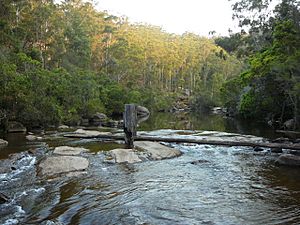
The Georges River begins east of Appin. It flows through rocky sandstone areas. It then goes past Campbelltown and alongside the Holsworthy Army Base.
When it reaches Glenfield, the river enters urban areas. It then flows through Liverpool and turns east. It passes suburbs like East Hills, Lugarno, and Blakehurst. Finally, it empties into Botany Bay at Taren Point.
River Branches and Activities
Several smaller rivers and creeks flow into the Georges River. These are called tributaries. Some major ones include O'Hares Creek, Cabramatta Creek, Prospect Creek, and the Woronora River.
The Georges River is a popular spot for fun activities. People enjoy water skiing and swimming there. The lower parts of the river have many large inlets and bays. These areas are surrounded by steep sandstone cliffs. Many expensive homes are built on these cliffs.
Chipping Norton Lakes
In the suburb of Chipping Norton, there are artificial lakes. These are known as the Chipping Norton Lakes. They were created in the 1900s from sand mining. Today, these lakes are a great place for watersports. They are also used for recreation by people living in southwest Sydney.
The Liverpool Weir is a dam on the river. It marks the point where the river water becomes salty. This is the highest point that tides can reach.
Protected Areas
The Georges River National Park is next to the upper parts of the river. A large area from Appin to Glenfield is protected. It's called the Georges River Regional Open Space Corridor. There are also council reserves where you can access natural parts of the river. These include Simmo's Beach and Frere's Crossing.
A group called the Botany Bay Community River Health Monitoring Program helps check the river's health. They make sure the river's environment stays healthy.
History of the Georges River
Aboriginal History
Before Europeans arrived, the Georges River was known as the Tucoerah River. This was its name given by the Aboriginal peoples who lived there. They were the original guardians of the land.
European History
The river got its English name, Georges River, from Governor Arthur Phillip. He named it in honor of King George III.
The Georges River was a site of the Hawkesbury and Nepean Wars. These were conflicts between the British and Aboriginal clans. They happened in the late 1700s and early 1800s.
Bass and Flinders explored the river in 1795. They were on their first trip in the Tom Thumb boat. This exploration helped lead to the founding of Bankstown.
In 1836, a dam was built at Liverpool. David Lennox oversaw its construction using convict labor. This dam provided water for the town of Liverpool.
In 2007, Liverpool and Campbelltown City Councils received a grant. It was for $2 million from the NSW Environmental Trust. This money helped them plan how to restore the river's catchment area. They worked with Wollondilly Shire Council and other groups.
Crossings Over the Georges River
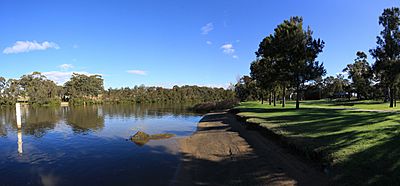
Many bridges cross the Georges River. Here are some of them, listed from east to west:
- Captain Cook Bridge: Connects Sans Souci to Taren Point. It's for cars, walkers, and cyclists.
- Tom Uglys Bridge: Connects Blakehurst to Sylvania. It's also for cars, walkers, and cyclists.
- Old Como railway bridge: Now used by walkers and cyclists.
- Como railway bridge: For trains on the Illawarra line. It connects Oatley to Como.
- Alfords Point Bridge: Connects Padstow Heights to Alfords Point. It's for cars, walkers, and cyclists.
- East Hills rail bridge: For trains on the Airport & South Line.
- Voyager Point footbridge: For walkers and cyclists.
- M5 South Western Motorway Georges River East Bridge: Part of a major motorway.
- Milperra Bridge: Connects Moorebank to Milperra. It's for cars, walkers, and cyclists.
- Governor Macquarie Drive bridge: Connects Warwick Farm to Chipping Norton. For cars, walkers, and cyclists.
- Liverpool Weir: Built in 1836.
- Newbridge Road: Connects Liverpool to Chipping Norton. For cars, walkers, and cyclists.
- M5 South Western Motorway Georges River West Bridge: Another part of the motorway.
- Airport & South Line rail bridge: Connects Holsworthy to Glenfield for trains.
- Cambridge Avenue Causeway: Connects Holsworthy to Glenfield for cars.
- King Falls Bridge.
Fish and Wildlife
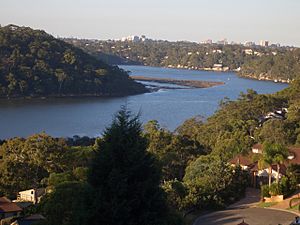
The Georges River is a popular spot for fishing. Many types of fish live here. These include bass, bream, whiting, yellowtail, jewfish, and flathead.
The river also has many oyster farms. These farms grow oysters for food. During summer, the upper parts of the river have many bass fish. In winter, these bass move closer to the salty water to lay their eggs.
Water flowing into the river is carefully managed. This helps keep the river healthy for all the plants and animals that live there.
See also
 In Spanish: Río Georges para niños
In Spanish: Río Georges para niños


